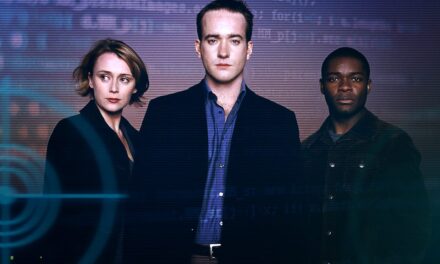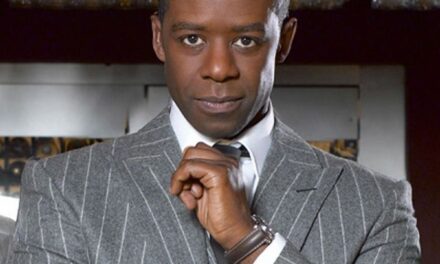Several of my previous blogs have dealt with female villains on television, and have mentioned the phenomena (by no means exclusive to TV) of ‘evil cleavage’. For some time I have promised myself I will write on this topic at more length, and was prompted to finally do so by some recent work I’ve been doing on older female characters and actors, and by several news items in the last few months about aging female actors.
Even real cleavage can be evil, especially when it’s flaunted by an older woman. Piers Morgan’s criticism of Susan Sarandon’s ‘horribly inappropriate’ cleavage-baring outfit predictably provoked a barrage of debate and rebuttal, not least by Sarandon herself.


While Morgan’s tweet did not specifically refer to Sarandon’s age as a factor in the ‘horrible inappropriateness’ of her choice of outfit, I did find myself wondering if he would have been so outraged had she been younger.

Coming as it did soon after Carrie Fisher versus Harrison Ford’s aging in Star Wars: The Force Awakens was being discussed, and shortly before the Daily Mail‘s suggestion that Gillian Anderson had had Botox elicited a flood of support for Anderson, the cleavage comment played into increasing discussion about female aging and the (under)employment of older female actors.
Penny Anderson, writing in the Guardian, praises BBC crime drama Happy Valley for casting many older female actors and portraying the complexities of older women’s lives. ‘I am of a similar vintage and, like many friends and fans of the series, bemoan the fact that we are generally treated by society as silly, weak, daft, soppy, prejudiced (even bigoted), risk-averse and wary of new situations.’ She goes on, ‘Alternatively, we are “mutton dressed as lamb” (I hate that phrase) for daring to reject an established age-acceptable dress code of cardigans and sensible shoes.’ (The ‘evil cleavage’ tendency certainly seems directly related to the ‘mutton dressed as lamb’ categorisation). Likewise, US series American Horror Story co-creator and writer Ryan Murphy has been praised by many of the female actors who feature in it for writing as Sarah Paulson says, “’complicated women and strong women and weak women and just all kinds of women” (“Enter the Coven” DVD feature) and American Horror Story: Coven in particular casts a large number of older women. Series like Happy Valley and American Horror Story highlight just how unusual this is in television, demonstrating valorisation of youth and continued adherence to strict parameters of ‘beauty,’ as well as of what female characters can and can’t do, say or wear. Admittedly, these series, and other examples of older female characters on TV, indicate that things are changing, however slowly.
The factors influencing the whole ‘evil cleavage’ issue are fairly obvious. The majority of female characters in popular media are defined by appearance and are often sexualised. Such sexualisation—often demonstrated by revealing clothing—applies even to heroic female characters, as Lisa Purse points out in her book Contemporary Action Cinema (2011). Purse notes that the increase in female action heroes in the late 1990s, particularly on television, was shaped by influences that resulted in ‘a female action hero that is overtly sexualised, a tendency evident in tight fitting or revealing costumes’ (78-9) and she paraphrases Yvonne Tasker on how this serves to ‘recontain’ such women within familiar structures of ‘heteronormative sexualised display’ (79).
Tight fitting and (cleavage-)revealing costumes often serve as visual shorthand for evil (like wearing leather trousers), even for younger female characters. BBC’s family fantasy adventure series Merlin continually presented Morgana (Katie McGrath) in cleavage-baring pseudo-period costumes, highlighting the fact that she was an Evil Queen in the making. In Buffy the Vampire Slayer, when nerdy Willow (Alison Hannigan) has to pose as her evil vampire doppelganger, cleavage is an integral part of her ‘evil’ identity.


Likewise, when Peggy Carter (Hayley Atwell) goes undercover in season 1 of Agent Carter, her ‘disguise’ entails wearing a blonde wig and a shoulder- and décolletage-baring gown quite unlike her usual style of dress.
In terms of older female antagonists or villains, the amount of cleavage exposed seems to offer a measure of evil. This is nothing new, and female villains fromDynasty’s Alexis Colby (Joan Collins) toSons of Anarchy season 6’s Alice Noone (Adrienne Barbeau) flaunt what Morgan would call ‘horribly inappropriate’ cleavage as a signal that they also flaunt social rules about female decorum and (especially sexual) behaviour.


Fantasy genres on TV in particular like to indulge in evil cleavage: costume is usually a key factor in the world-building and distinctive visual styles of science fiction, horror or high fantasy. One of my previous CST blogs mentioned Helen Cutter (Juliet Aubrey) in Primeval: Helen was a one-dimensional character defined by her three-dimensional cleavage, which was obviously considered almost too evil to be fully exposed, covered as it often was by scarves or overshadowed by upturned collars and layers of nonetheless revealing clothing.

The style, colours and textures of her clothes constructed Helen as a time-travelling adventurer à la Lara Croft, and this character makes an interesting comparison with two older female women from the Doctor Who post-2005 stable—Sarah Jane Smith (Elisabeth Sladen) in The Sarah Jane Adventures and River Song (Alex Kingston) from Doctor Who. The costuming of both Sarah Jane and River draw on similar influences though, as a hero and a much older woman, Sarah Jane is less defined by her cleavage: despite her signature waistcoats she tends to not to be unbuttoned low enough for actual cleavage to show. Arguably because of the series position as children’s drama, Sarah Jane is never really sexualised: River, introduces herself as Professor River Song (‘Silence in the Library’ 4.8) and spends much of her first story wearing a bulky spacesuit, yet she is increasingly sexualised and subsequent storylines reinvent her variously as a femme fatale, a psychotic killer and a clingy lover, functions that emphasise traditional femininity. I noted in 2013 that Helen Cutter was so defined by her evil cleavage that it was a prominent feature of her action figure, and the Funko second wave of Doctor Who Pop! Vinyls notably offers River in action hero boots, carrying a gun, but wearing a dress with an almost-cleavage-baring neckline.

Once Upon A Time has consistently offered a plethora of truly fantastic costumes for its characters, many of whom are women. Several variations of #EvilCleavage serve as Twitter feeds for followers of its Queen of Evil Cleavage, Regina (Lana Parrilla), and one at least describes itself as ‘dedicated to the glorious bosom of Lana Parrilla—the Evil Cleavage.’ The series surpassed itself in the evil cleavage stakes with season 4, which featured no fewer than six older female villains–all with evil cleavage. Two of them had previously featured in the series: original Evil Queen Regina was a main character from the start, and Rebecca Mader debuted in season 3 as Zelena, Regina’s competitive sister, whose identity as the Wicked Witch of the West allowed her to take sibling rivalry to a whole new level by offering her own version of evil cleavage, in green.

The two halves of season 4 each featured evil cleavage characters. Ingrid, the Ice Queen, aunt of Frozen’s Elsa (Elizabeth Mitchell), whose cleavage almost deserves its own billing, is a key antagonist in the first half. (One episode ‘recap’ on AfterEllen takes great delight in recalling Ingrid’s rematerialisation ‘boobs first,’ obviously at least as entertained as I was by the ultimate in evil cleavage on the series so far). The second half of this season introduces a band of female villains, Sea Witch Ursula (Merrin Dungey), Maleficent (Kristin Bauer von Straten) and Cruella de Vil (Victoria Smurfit), all wearing plunging necklines.


The alignment of cleavage with evil is amply demonstrated here since two of the three end up rehabilitated, at which point their cleavage goes into retirement. Ursula is eventually reunited with her father Poseidon and returns home to the sea, while Maleficent oscillates between good and evil, having already been partially rehabilitated in the Disney film which presented her point of view. Notably, in present day Storybrooke, Maleficent wears sharp retro suits (not unlike Agent Carter’s) combined with shirts and ties that completely cover her evil cleavage, suggesting that she can be won over to good, while still queering her sufficiently to imply that she will never be a conventional woman.
And finally, I don’t feel I can complete a blog about cleavage, heroic, villainous or morally ambivalent, without returning to American Horror Story. In line, perhaps, with its more nuanced depiction of older female characters by highly-skilled female actors, American Horror Story does not consistently use cleavage to denote evil. Angela Bassett’s debut role for the series, as voodoo queen Marie Laveau in Coven tended to wear jumpsuits, some with deep necklines, some without, seemingly in deliberate contrast to the more classic style of Supreme Witch Fiona Goode (Jessica Lange)—both characters are power dressing, but they articulate the power in different idioms. In American Horror Story: Freak Show, however, Bassett’s character was the triple-breasted Desiree Dupree, and promotional images for this season deliberately flaunted her (multiple) cleavage.

This was, presumably, conscious subversion of the usual ways older female characters, women of colour, and morally ambivalent female protagonists (and antagonists) are presented in TV drama. Desiree and the assorted wicked witches and evil queens of Once Upon a Time demonstrate that such exaggeration and parody can serve to both draw attention to and challenge the standard sexualisation of female characters, and the standard demonization of assertive, older female characters. Yet the images, especially out of context, also demonstrate the limitations of this hyperbole as a representational strategy, risking appearing to be the stereotyped sexualisation they parody. A post-evil cleavage society may be somewhere in the future; in the meantime, evil never looked so good.
Lorna Jowett is a Reader in Television Studies at the University of Northampton and coordinator of the Cult TV: TV Cultures Network. She is the co-author with Stacey Abbott of TV Horror: Investigating The Dark Side of the Small Screen (2013), author of Sex and the Slayer: A Gender Studies Primer for the Buffy Fan (2005) and co-editor of the forthcoming Time on Television. She has published many articles on television, film and popular culture, and her next book examines gender in the Doctor Who franchise.





